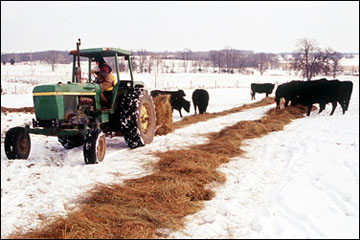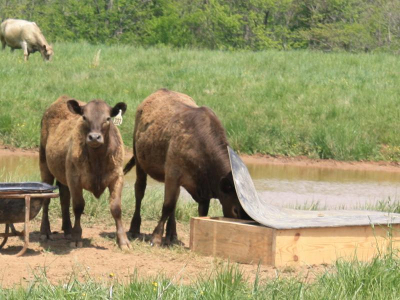
How to start mob grazing
 So how do you start a mob
grazing operation
from scratch? Say you've got an old potato field that keeps
eroding into the creek every year, and you've decided to turn it into
pasture to preserve (and build) topsoil. How do you make that
pasture happen, and what do you want it to look like?
So how do you start a mob
grazing operation
from scratch? Say you've got an old potato field that keeps
eroding into the creek every year, and you've decided to turn it into
pasture to preserve (and build) topsoil. How do you make that
pasture happen, and what do you want it to look like?
Instead of spreading a
lot of grass seed, Greg Judy recommends starting with hay. If you
unroll a lot of hay bales into the proto-pasture in the winter and
graze your livestock there (even though there's really nothing to graze
on), the hay will naturally seed the pasture, and will also add a bit
of starter biomass when livestock trample some into the soil.
You'll need to keep feeding your animals for the first year --- this is
worth it because you're building your soil every time the livestock
pass through.
In the second year, you
can finally plant some clover seeds, focusing on fall planting when the
baby clover won't be competing much with weeds. Unlike Voisin
grazing (which
believes more clover is always better), Greg Judy recommends
aiming for only 30% legumes since too much high nitrogen clover is bad
for beef cows.
 Meanwhile, start feeding your
animals free choice minerals in the summer, with each type of nutrient
in its own compartment. The livestock will only eat what's
deficient in the soil, and since about 70% of the minerals will pass
right through them, you'll be correcting soil nutrient imbalances at
the same time you're making your livestock healthier. Greg Judy
noticed that, after three years of mob grazing, his animals are now
eating only a quarter as much mineral as they used to, and they don't
touch any of the minerals at all when grazing on his highest quality
soil.
Meanwhile, start feeding your
animals free choice minerals in the summer, with each type of nutrient
in its own compartment. The livestock will only eat what's
deficient in the soil, and since about 70% of the minerals will pass
right through them, you'll be correcting soil nutrient imbalances at
the same time you're making your livestock healthier. Greg Judy
noticed that, after three years of mob grazing, his animals are now
eating only a quarter as much mineral as they used to, and they don't
touch any of the minerals at all when grazing on his highest quality
soil.
As your pasture grows,
don't worry if you start to see plants you're not familiar with.
If your recovery period is long enough, warm season perennials like
indian grass, big bluestem, and gama grass will spring up --- these are
great for summer grazing as long as you make sure to give them a long
rest period. Meanwhile, don't worry about a few "weeds" --- Greg
Judy believes that giant ragweed pumps minerals from deep in the soil,
which is why his cows love it. (They like tree leaves for the
same reason.) A well-managed pasture will become more diverse and
more like a native prairie every year.
 This post is part of our Mob Grazing lunchtime series.
Read all of the entries: This post is part of our Mob Grazing lunchtime series.
Read all of the entries:
|
Want more in-depth information? Browse through our books.
Or explore more posts by date or by subject.
About us: Anna Hess and Mark Hamilton spent over a decade living self-sufficiently in the mountains of Virginia before moving north to start over from scratch in the foothills of Ohio. They've experimented with permaculture, no-till gardening, trailersteading, home-based microbusinesses and much more, writing about their adventures in both blogs and books.
Want to be notified when new comments are posted on this page? Click on the RSS button after you add a comment to subscribe to the comment feed, or simply check the box beside "email replies to me" while writing your comment.

How would a cow detect which minerals it's missing from it's diet?
Wouldn't that e.g. require symptoms that are closely correlated to a single mineral?
I guess I can see that working for carbohydrates w.r.t. blood sugar levels.
But most minerals we only need in relatively low quantities. And there are several deficiency conditions (like iron deficiency) where we don't seem to have a reflex to eat certain foods.
Of course I'm not a biologist, so I could be talking out of my ass right now. It would be awesome if we could really sense our needs so accurately.
It would be awesome if we could really sense our needs so accurately.